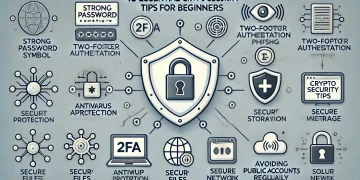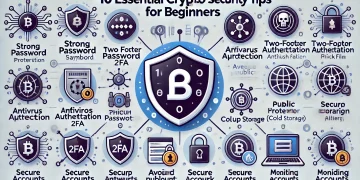In the fast-paced world of cryptocurrency trading, charts are your compass, guiding you through the turbulent seas of market volatility. Whether you’re a novice investor or looking to refine your trading strategy, understanding how to read and interpret cryptocurrency charts is crucial. This comprehensive guide will walk you through the basics of crypto charts, their types, key components, and how to use them effectively in your trading decisions.
Table of Contents
- Introduction to Cryptocurrency Charts
- Types of Cryptocurrency Charts
- Key Components of a Cryptocurrency Chart
- Understanding Candlestick Patterns
- Technical Indicators
- Chart Patterns
- Order Book and Depth Charts
- Using Charts for Trading Decisions
- Common Mistakes to Avoid
- Tools and Platforms for Cryptocurrency Charting
- Conclusion
Introduction to Cryptocurrency Charts
Cryptocurrency charts are visual representations of the historical price movements of a particular cryptocurrency over time. They serve as essential tools for traders and investors to analyze market trends, identify patterns, and make informed decisions about buying, selling, or holding digital assets.
Charts provide a wealth of information at a glance, including:
- Price movements
- Trading volume
- Market sentiment
- Support and resistance levels
- Potential trend reversals
By learning to read and interpret these charts, you’ll be better equipped to navigate the volatile cryptocurrency markets and develop effective trading strategies.
Types of Cryptocurrency Charts
There are several types of charts used in cryptocurrency trading, each with its own strengths and use cases. The three most common types are:
Line Charts
Line charts are the simplest form of price charts. They display a single line that connects the closing prices of a cryptocurrency over a specific time period. While they provide a clear view of overall price trends, they lack detailed information about price fluctuations within each time interval.
Bar Charts
Bar charts offer more information than line charts. Each bar represents a specific time period (e.g., one day, one hour) and shows four key price points:
- Opening price
- Highest price
- Lowest price
- Closing price
The vertical line of each bar represents the price range between the highest and lowest prices, while small horizontal lines on the left and right indicate the opening and closing prices, respectively.
Candlestick Charts
Candlestick charts are the most popular and informative type of charts used in cryptocurrency trading. Like bar charts, they display the opening, closing, highest, and lowest prices for each time period. However, candlestick charts use a more visually intuitive format:
- The “body” of the candlestick represents the range between the opening and closing prices.
- The “wicks” or “shadows” extend from the body to show the highest and lowest prices.
- Green (or white) candlesticks indicate that the closing price was higher than the opening price (a price increase).
- Red (or black) candlesticks indicate that the closing price was lower than the opening price (a price decrease).
Candlestick charts allow traders to quickly assess market sentiment and identify potential trend reversals based on candlestick patterns.
Key Components of a Cryptocurrency Chart
To effectively read and interpret cryptocurrency charts, you need to understand their key components:
Time Frame
The time frame of a chart refers to the duration represented by each data point (candle or bar). Common time frames include:
- 1 minute
- 5 minutes
- 15 minutes
- 1 hour
- 4 hours
- 1 day
- 1 week
- 1 month
Shorter time frames (e.g., 1 minute, 5 minutes) are typically used for day trading and short-term analysis, while longer time frames (e.g., 1 day, 1 week) are used for identifying long-term trends and making investment decisions.
Price Scale
The price scale, usually located on the right side of the chart, shows the range of prices for the cryptocurrency being analyzed. It can be displayed in linear or logarithmic scale:
- Linear scale: Equal distances on the scale represent equal price changes.
- Logarithmic scale: Equal distances represent equal percentage changes, which can be more useful for long-term analysis and comparing assets with significantly different price ranges.
Volume
Trading volume, often displayed as a bar chart at the bottom of the price chart, represents the number of units of a cryptocurrency traded within a specific time period. Volume is an important indicator of market interest and can help confirm trends or signal potential reversals.
Understanding Candlestick Patterns
Candlestick patterns are formations created by one or more candlesticks that can indicate potential price movements. Traders use these patterns to make predictions about future price action. Some common patterns include:
Bullish Patterns
- Hammer: A single candlestick with a small body near the top and a long lower wick, indicating a potential bullish reversal.
- Bullish Engulfing: A large green candlestick that completely engulfs the previous red candlestick, signaling a potential trend reversal.
- Morning Star: A three-candle pattern consisting of a large red candle, a small-bodied candle, and a large green candle, indicating a potential bottom and bullish reversal.
Bearish Patterns
- Shooting Star: A single candlestick with a small body near the bottom and a long upper wick, indicating a potential bearish reversal.
- Bearish Engulfing: A large red candlestick that completely engulfs the previous green candlestick, signaling a potential trend reversal.
- Evening Star: A three-candle pattern consisting of a large green candle, a small-bodied candle, and a large red candle, indicating a potential top and bearish reversal.
Technical Indicators
Technical indicators are mathematical calculations based on price, volume, or other data points that help traders analyze market trends and make predictions about future price movements. Some popular indicators include:
Moving Averages
Moving averages smooth out price data to create a single flowing line, making it easier to identify trends. Common types include:
- Simple Moving Average (SMA)
- Exponential Moving Average (EMA)
Traders often use crossovers between short-term and long-term moving averages as buy or sell signals.
Relative Strength Index (RSI)
The RSI is a momentum oscillator that measures the speed and change of price movements. It oscillates between 0 and 100, with readings above 70 generally considered overbought and below 30 considered oversold.
Bollinger Bands
Bollinger Bands consist of a middle band (usually a 20-period SMA) and two outer bands that are two standard deviations away from the middle band. They help identify periods of high and low volatility and potential breakouts.
Chart Patterns
Chart patterns are formations that appear on price charts and can indicate potential future price movements. Some common patterns include:
Head and Shoulders
A reversal pattern consisting of three peaks, with the middle peak (head) being higher than the two surrounding peaks (shoulders). It often signals a bullish-to-bearish trend reversal.
Double Top and Double Bottom
Double tops and double bottoms are reversal patterns that occur when the price reaches the same level twice, forming two peaks (double top) or two troughs (double bottom). These patterns can signal a potential trend reversal.
Triangle Patterns
Triangle patterns occur when price movements converge to a single point, forming a triangle shape. Common types include:
- Ascending triangles (bullish)
- Descending triangles (bearish)
- Symmetrical triangles (neutral)
These patterns can indicate potential breakouts or breakdowns.
Order Book and Depth Charts
While not technically part of the price chart, the order book and depth charts provide valuable information about market liquidity and potential support and resistance levels:
- Order Book: Displays current buy and sell orders at different price levels.
- Depth Chart: Visualizes the cumulative volume of buy and sell orders at various price points.
Understanding these tools can help you gauge market sentiment and identify potential areas of price support or resistance.
Using Charts for Trading Decisions
To effectively use cryptocurrency charts in your trading decisions:
- Identify trends: Look for overall price direction (uptrend, downtrend, or sideways movement) using multiple time frames.
- Spot support and resistance levels: Identify price levels where the cryptocurrency has historically found support (bounced up) or resistance (failed to break through).
- Use multiple indicators: Combine different technical indicators to confirm signals and reduce false positives.
- Look for chart patterns: Identify common chart patterns that may indicate potential trend reversals or continuations.
- Consider volume: Use volume data to confirm trends and identify potential reversals.
- Practice risk management: Use charts to set stop-loss and take-profit levels based on support and resistance levels or other technical factors.
Common Mistakes to Avoid
When using cryptocurrency charts, be aware of these common pitfalls:
- Over-reliance on a single indicator: No single indicator is perfect. Use multiple indicators and analysis methods to make informed decisions.
- Ignoring fundamental analysis: Charts don’t tell the whole story. Consider fundamental factors like project developments, partnerships, and market news.
- Emotional trading: Don’t let fear or greed drive your decisions. Stick to your trading plan and use charts objectively.
- Neglecting risk management: Always use stop-loss orders and proper position sizing to protect your capital.
- Analysis paralysis: Don’t get overwhelmed by too many indicators or time frames. Find a balance that works for your trading style.
Tools and Platforms for Cryptocurrency Charting
There are numerous tools and platforms available for cryptocurrency charting, including:
- TradingView: A popular web-based charting platform with a wide range of features and indicators.
- Coinigy: A comprehensive cryptocurrency trading and charting platform that integrates with multiple exchanges.
- Crypto Pro: A mobile app for iOS and Android that offers real-time charts and portfolio tracking.
- Binance: One of the largest cryptocurrency exchanges, offering advanced charting tools within its trading interface.
- CryptoWatch: A web-based charting platform owned by Kraken exchange, offering real-time data and customizable charts.
Experiment with different platforms to find one that suits your needs and trading style.
Conclusion
Understanding cryptocurrency charts is an essential skill for anyone looking to navigate the volatile world of digital asset trading. By mastering the basics of chart types, candlestick patterns, technical indicators, and chart patterns, you’ll be better equipped to analyze market trends and make informed trading decisions.
Remember that chart analysis is just one part of a comprehensive trading strategy. Combine your technical analysis skills with fundamental research, risk management techniques, and a solid understanding of market dynamics to improve your chances of success in the cryptocurrency markets.
As you continue to learn and practice, you’ll develop your own unique approach to chart analysis and trading. Stay curious, keep learning, and always be prepared to adapt your strategies as the market evolves. With time and experience, you’ll gain the confidence to navigate the exciting world of cryptocurrency trading using charts as your guide.






























